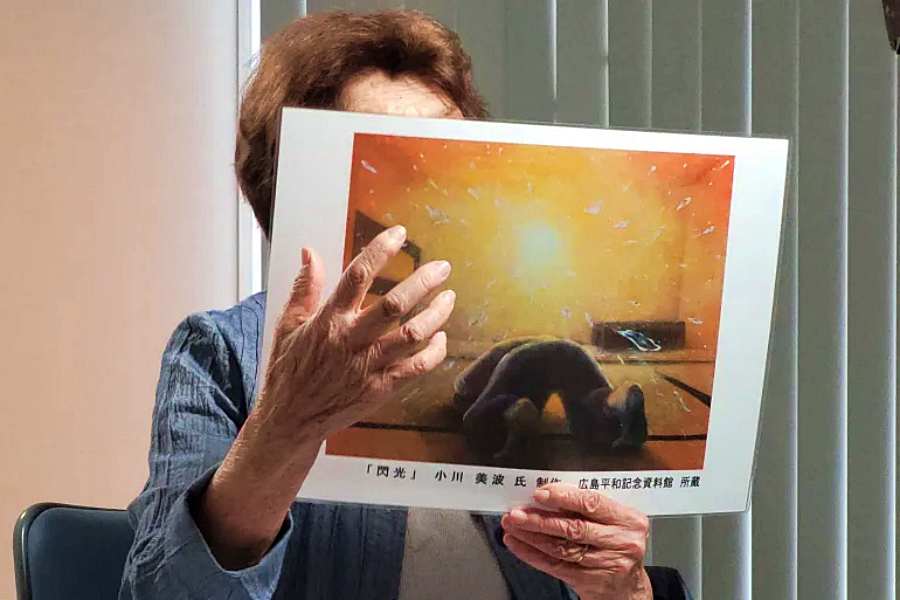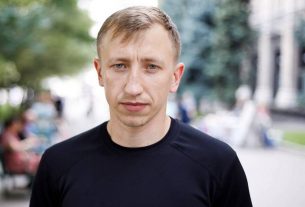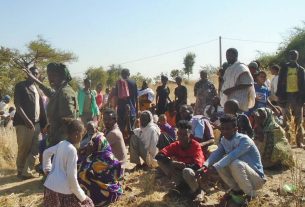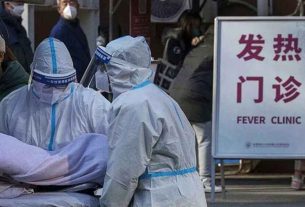![]() Sadae Kasaoka shows pictures that students drew of her recollection of what happened in Hiroshima on August 6, 1945 [Laura Goehler/Al Jazeera]
Sadae Kasaoka shows pictures that students drew of her recollection of what happened in Hiroshima on August 6, 1945 [Laura Goehler/Al Jazeera]
Fri 19 May 2023:
As the G7 summit takes place in Japan, survivors of the 1945 atomic bomb caution leaders about the human cost of nuclear weapons.
Hiroshima, Japan – “It looked like a bright orange light, like the first sunrise of the year,” says Sadae Kasaoka, remembering the moment when the first nuclear bomb to ever be used was dropped by the United States on the Japanese city of Hiroshima.
Now 90, she was 12 years old that August day at the tail end of World War II, but she still remembers it vividly.
Sadae was home alone with her grandmother. When the blast hit, she was pushed against the wall by the massive force of the explosion and covered in broken glass. The two then fled into an air raid shelter for safety.
Sadae pauses, her voice trembling as she goes on to recall the events of August 6, 1945. “A neighbour told us the whole city was on fire,” she says.
For hours she did not know whether her parents had survived. When her brother brought her father’s body home, he was alive, but so severely burned that she could not recognise him.
“He was all black. His eyes were popping out. Finally, I recognised him by his voice. He said ‘Give me water’. And he asked me to go looking for my mother,” Sadae says, taking a breath. “Someone told me you shouldn’t give them water, so I did not give him any water, but that is something I still regret deeply.”
Sadae’s father died two days later. The following day she found out her mother was killed and already cremated along with many other victims.

The exact number of deaths from the uranium bomb remains unclear to this day, with a large gap between the lowest and highest estimates. The City of Hiroshima reports that by the end of 1945 up to approximately 140,000 people – out of a population of 350,000 – had died either in the explosion itself or from the effects of acute radiation poisoning. Most were civilians.
Days later, on August 9, a larger plutonium bomb was then dropped on Nagasaki – some 400km (248 miles) away from Hiroshima. According to the Nobel Peace Prize-winning International Campaign to Abolish Nuclear Weapons (ICAN), around another 74,000 people lost their lives there by December 1945. Many of those who survived suffered from long-term illnesses.
The first and last atomic bombs ever dropped on a civilian population, the Hiroshima and Nagasaki attacks are often seen as a uniquely horrible moment in human history. But with countries building up weapons capabilities and threats of nuclear options in Russia’s war against Ukraine, many fear that humanity is not doing enough to avoid repeating itself. With the Group of Seven (G7) summit taking place in Hiroshima this week, some survivors see it as an opportunity to remind world leaders what the real costs are.
‘All my friends died’
Toshiko Tanaka grew up in Hiroshima. When the explosion hit, the then-six-year-old suffered burns as well as exposure to radiation, but miraculously survived.
Today the 84-year-old uses a stick to help herself walk, but otherwise seems to be in good health. However, the traumatic memories of that fateful day will forever be imprinted in her mind.
It was a school day, Toshiko remembers. On their way to class, she and a friend noticed a plane overhead. When someone yelled “enemy”, Toshiko looked up to the sky. Then she saw the light.
“I instinctively covered my face,” she says, recalling that she used her right arm to protect herself. That night she developed a high fever. “I don’t remember much. I lost consciousness.”

One of her most vivid memories from that time was the smell of burning corpses in the days after the explosion. The authorities had started cremating the bodies of those who died.
“I was traumatised,” she says. “All my friends from school died and for a very long time I couldn’t speak about what happened.”
When she was 70, Toshiko went on a boat trip organised by the Japanese non-profit Peaceboat, an initiative inviting survivors of the atomic bomb on a journey around the world telling their stories. That is when she realised she had to speak up and finally share her testimony, she says.
Today she wants everyone to know how dangerous nuclear weapons are to mankind and the unimaginable suffering they cause. “I want our leaders to see what happened in Hiroshima and imagine what would happen to your family, to your friends, if a bomb was dropped on them.”
Toshiko started travelling to the US and learned a little English to tell her story; she’s made 10 such trips in the past seven years.
She speaks as a “hibakusha” – a Japanese term for those affected by the bombings of Hiroshima and Nagasaki. At the last count in 2021, an estimated 42,000 hibakushas were still living in Hiroshima, according to the Japanese Ministry of Health. The average age then was 84. Soon what happened in Hiroshima will pass beyond living memory.

‘Credible, actionable plan’ for disarmament
In 2016, Barack Obama became the first sitting US president to meet with survivors at Hiroshima’s Peace Memorial Park during a historic trip. This year, Japanese Prime Minister Fumio Kishida has invited his fellow G7 leaders to his family’s native city – a summit that includes another visit to the park, where the Atomic Bomb Dome, the only structure left standing in the area after 1945, remains.
Daniel Högsta, the interim executive director of ICAN, wants to see leaders of the G7 commit to a “credible, actionable plan” on nuclear disarmament, one that involves a treaty on the prohibition of nuclear weapons. “Anything less than that would be insulting to the hibakusha,” he tells Al Jazeera. “It would also be a failure of leadership.”
For Toshiko, the visit could not be more crucial at a time when some say the world is closer to a nuclear war than it has been in decades.
“I want them to really pay attention to what happens when you use a nuclear weapon,” she says. “There is a war in Ukraine now and this summit should not be a place where you make military preparations.” She wants this meeting to be about finding a way back to peace.

Schoolchildren visit the Peace Memorial Park in Hiroshima, with the iconic ‘Atomic Bomb Dome’, the only structure left standing in the area after 1945, visible behind them [Laura Goehler/Al Jazeera]
While walking through the Peace Memorial Park, Toshiko shares that as a child she used to swim in the Motoyasu River between the park and the iconic Atomic Bomb Dome, which used to be part of Hiroshima Prefectural Industrial Promotion Hall – an exhibition space.
But she doesn’t like coming to the area anymore. It reminds her that it was once a bustling city centre of Hiroshima. “Then all of a sudden it was gone,” she says, explaining the unease she feels being there now.
However, she thinks it is important for the world to know what happened in this place. So does her fellow hibakusha Sadae, who now gives talks at the nearby Peace Memorial Museum. “Nuclear weapons should not exist, they should not be built and that’s why we are raising our voice,” she answers when asked about her message to the world leaders coming to her city.
World War II ended with Japan’s formal surrender on September 2 that year, nearly 80 years ago. Yet the horrors of what happened and the dangers of nuclear war feel ever more present – especially to those who remember first-hand one of the darkest days in history.

Taro Irei, James Bays and Brendan Ager contributed to this report.
FOLLOW INDEPENDENT PRESS:
TWITTER (CLICK HERE)
https://twitter.com/IpIndependent
FACEBOOK (CLICK HERE)
https://web.facebook.com/ipindependent
Think your friends would be interested? Share this story!





